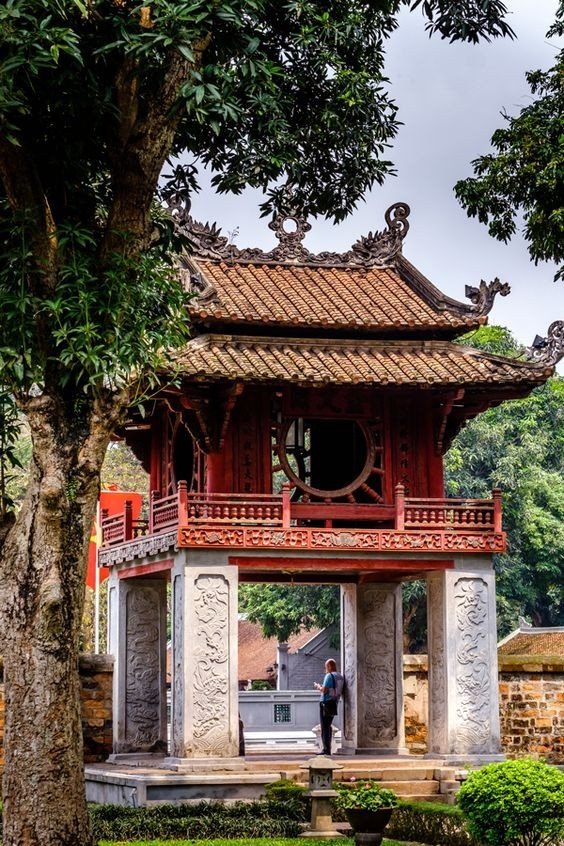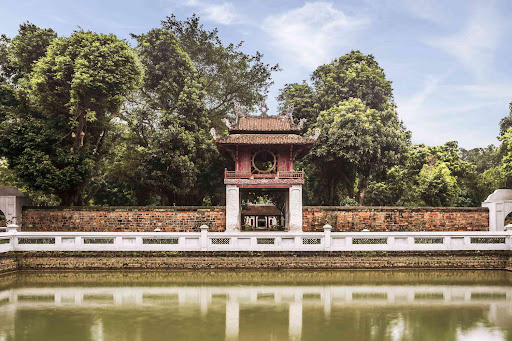Temple of Literature, located near the Old Quater, is as a testament to Hanoi’s long-standing history. This iconic landmark not only serves as a popular tourist destination but also holds profound significance as a symbol of learning and education in Vietnam.
History of the Temple of Literature
Established in
1070, the place (Van Mieu) was initially built to honor the ancestors of Confucianism. Just six years later, in
1076, the adjacent
National University (Quoc Tu Giam) was founded, making it the first university in Vietnam. Originally, Quoc Tu Giam exclusively catered to the offspring of royalty and government officials. However, under the reign of King Tran Thai Tong in
1253, it was opened to exceptionally gifted commoners, marking a pivotal shift towards inclusivity in education. This transformation solidified Quoc Tu Giam’s reputation as a beacon of learning for all.Throughout the
Le Dynasty, Confucianism flourished in Vietnam, greatly influencing its cultural and educational landscape. Today, the
82 Stone Stele, which was erected on 1653,
along with Quoc Tu Giam stands as a living testament to the nation’s educational progress.

Unique Architecture
The place has a distinctive architectural style that reflects its historical significance. Spanning over
54,331 square meters, the complex is divided into five main courtyards, each serving a specific purpose.
- First Courtyard – Khu Nhap Dao: Welcoming visitors with the grandeur of the Great Middle Gate, this expansive area features lush gardens and pathways, providing a serene escape from the bustling city.
- Second Courtyard – Khue Van Cac: Symbolizing the nobility of Confucianism, this courtyard is adorned with the iconic Khue Van Cac, a two-story structure representing the harmony of yin and yang.
- Third Courtyard – Bia Tien Si: Home to the prestigious Doctor’s Stele and the Well of Heavenly Clarity, this area pays homage to scholars of exceptional talent.
- Fourth Courtyard – Dai Thanh: Serving as the heart of the complex, this courtyard is dedicated to the worship of Confucius and his disciples, featuring remarkable architecture and tranquil spaces for contemplation.
- Fifth Courtyard – Nha Thai Hoc: Providing a peaceful retreat, this area houses a beautiful garden and a shrine dedicated to the kings of the Ly dynasty, offering visitors a moment of reflection.
Philosophy of Yin and Yang in Architecture
Central to the architecture of the complex is the profound philosophy of yin and yang. Rooted in the concept of harmony between heaven and earth, this philosophy is intricately woven into every aspect of the complex’s design.From the symmetrical layout of the courtyards to the intricate details of the entrance gate, the yin-yang philosophy is evident in every corner. The balance between opposing forces is not only a testament to ancient beliefs but also serves as a guiding principle for architectural harmony.

Guide to Visit Temple of Literature
Located in the heart of Hanoi, at
58 Quoc Tu Giam Street, this place welcomes visitors from all walks of life. Admission prices are reasonable, with adult tickets priced at
VND 70,000 per person (updated on April 2024). Discounts are available for children under 15, students, and individuals with disabilities.Visitors are encouraged to dress respectfully and adhere to visitor guidelines. It’s recommended to cover your shoulder and kneeds when you’re visiting the shrines.
Conclusion
The
Temple of Literature stands as a timeless symbol of learning, culture, and tradition in Hanoi. From its humble beginnings as a place of worship to its evolution into Vietnam’s first university, this iconic landmark continues to inspire generations of scholars and visitors alike. As you explore its storied halls and manicured gardens, you’ll embark on a journey through centuries of history and heritage. After your visit, you will have a deeper understanding of Vietnam’s rich cultural heritage and history. If you’re interested in visiting this iconic symbol, please follow our
Hanoi tour to learn more.


